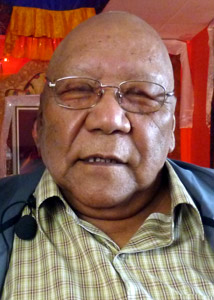Name: Thinley Paljor Shasok
(Alias: No)
Gender: Male
Interview Age: 71
Date of Birth: 1943
Birthplace: Shigatse, Utsang, Tibet
Year Left Tibet: 1952
Profession: N/A
Monk/Nun: No
Political Prisoner: No

Interview No.: 3C
Date: 2013-05-03
Language: English
Location: Richmond, California, United States
Categories: Resistance and Revolution
Keywords: childhood memories, Chinese army -- invasion by , CIA training, education, guerrillas in Mustang, resistance fighters, trade, Utsang
Summary:
Thinley Paljor Shasok belonged to a middle class family living in Shigatse, one of the main trading centers between India and Tibet. His father and elder brother were merchants buying wool from Changthang in western Tibet, selling them in Kalimpong, India and bringing goods from India to be sold in Tibet. Thinley Paljor was one among the very small group of Tibetans who went to school. He recounts attending a private school in Tibet and later his elder brother enrolled him in an international school in Kalimpong where he learned English.
Thinley Paljor lost contact with his family in Tibet after the Chinese invasion in 1959. Around that time he was persuaded by Mr. Gyalo Thondup, brother of His Holiness the Dalai Lama, to act as an interpreter for a very secret mission and help the Tibetans fight against the Chinese. He explains how he was temporarily stationed with a small group of Tibetans in Saipan and then Okinawa before finally being transported to Camp Hale in Colorado.
The CIA provided military to train the Tibetans in guerrilla warfare, weapons and intelligence gathering. Thinley Paljor served as an interpreter for the trainees. He shares his views on why the Americans helped the Tibetans and also why the support abruptly ended. Thinley Paljor talks about his role as a translator during the training and what this operation meant to him as a Tibetan. He explains how the trainees were returned to Tibet and Mustang, Nepal to fight.
Interview Team:
- Marcella Adamski (Interviewer)
- Jeddadiah Emanuel (Videographer)

